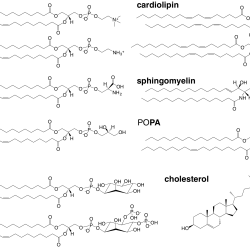
Influence of lipids on transmembrane transport proteins
Transmembrane proteins are responsible for transporting ions and small molecules across the hydrophobic region of the cell membrane. In our review Influence of lipids on protein-mediated transmembrane transport1 we are looking at the evidence for regulation of these transport processes by interactions with the lipids of the membrane. We focus on ion channels, including potassium channels, mechanosensitive and pentameric ligand gated ion channels, and active transporters, including pumps, sodium or proton driven secondary transporters and ABC transporters.
There is an an enormous variety in lipid composition of membranes as shown in the table below. The composition differs between organisms, organelles, and even by temperature. Cells exert tight control on the makeup of their membranes, partly because physical properties of the membrane depend strongly on the type and amount of lipids. Thus, it is an important question how membrane proteins interact with and depend on the specifics of the membrane.
| Organism | Membrane/tissue | PC | PE | PI | PS | SM | CL | PG | PA | Other |
|---|---|---|---|---|---|---|---|---|---|---|
| a PC, phosphatidylcholine; PE, phosphatidylethanolamine; PI, phosphatidylinositol; PS, phosphatidylserine; SM, sphingomyelin; CL, cardiolipin (diphosphatidylglycerol); PG, phosphatidylglycerol; PA, phosphatic acid; LPS, lipopolysaccharide. | ||||||||||
| b exponentially grown cells; stationary phase cells are enriched in CL | ||||||||||
| c total E. coli outer membrane contains about 50% lipopolysaccharide (LPS); the inner leaflet consists of about 90% PE while the outer leaflet contains almost exclusively LPS | ||||||||||
| d sterols are the overall majority component, ergosterol:phospholipid 3.31:1 mol/mol | ||||||||||
| e plasmalogen (PC/choline plasmalogen or PE/ethanolamine plasmalogen) | ||||||||||
| Escherichia coli | plasmab | – | 75 | – | – | – | 5 | 20 | – | – |
| outer | – | 45 | – | – | – | – | – | – | 55 (LPS)c | |
| B. subtilis | plasma | – | 12 | – | – | – | 4 | 70 | – | 14 |
| C. glutamicum | plasma, 10 °C | – | – | 24 | – | – | 17 | 53 | 2 | 4 |
| plasma, 30 °C | – | – | 33 | – | – | 25 | 35 | 3 | 4 | |
| plasma, 40 °C | – | – | 20 | – | – | 57 | 13 | 2 | 4 | |
| S. cerevisiae | plasmad | 17 | 20 | 18 | 34 | – | 0 | – | 4 | 7 |
| inner (mitoch.) | 40 | 24 | 16 | 4 | – | 16 | – | 2 | – | |
| outer (mitoch.) | 46 | 33 | 10 | 1 | – | 6 | – | 4 | – | |
| Homo sapiens | muscle | 48 | 26 | 9 | 3 | 4 | 5 | – | 1 | 3 |
| brain | 34 | 13/20e | 3 | 11 | 14 | 2 | – | – | 3 | |
For ion channels it has been convincingly shown that specific lipid-protein interactions can directly affect their function. In some cases, a combined approach of molecular and structural biology together with computer simulations has revealed the molecular mechanisms. There are also many transporters whose activity depends on lipids but we are only beginning to understand the molecular mechanisms. In all areas, however, the use of computer simulations extends the way in which we understand protein-membrane interactions.
References
1 E. J. Denning and O. Beckstein. Influence of lipids on protein-mediated transmembrane transport. Chem Phys Lipids 169 (2013), 57–71. doi: 10.1016/j.chemphyslip.2013.02.007 . Also available from the ASU Digital Repository under accession number 18246


Discuss: “Influence of lipids on transmembrane transport proteins”